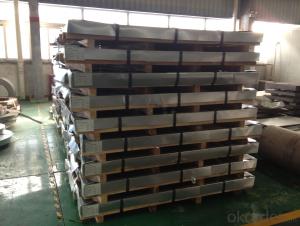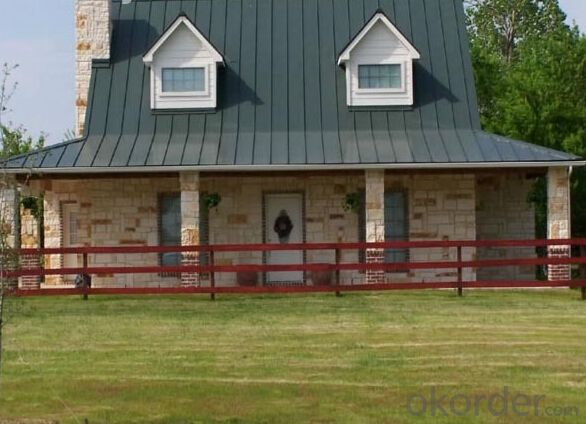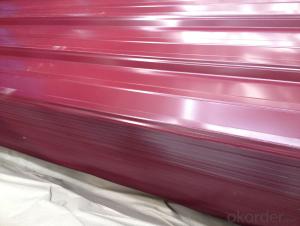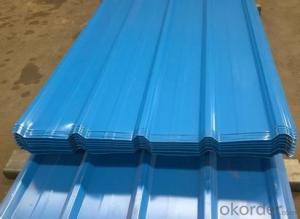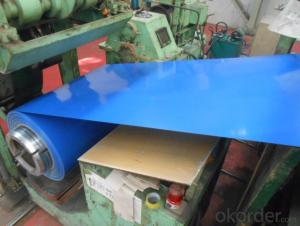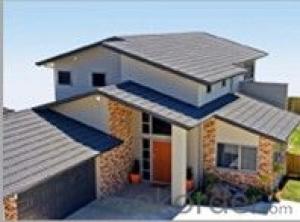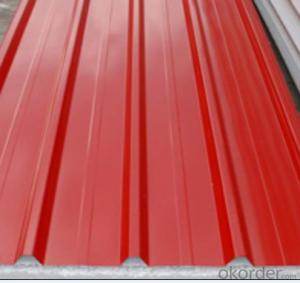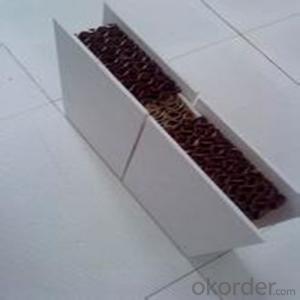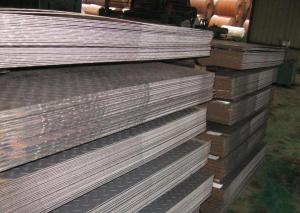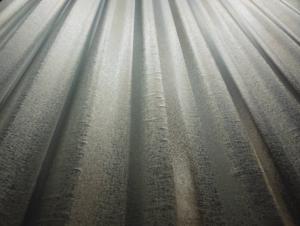Prepainted galvanized corrugated steel sheet
- Loading Port:
- China Main Port
- Payment Terms:
- TT OR LC
- Min Order Qty:
- -
- Supply Capability:
- -
OKorder Service Pledge
OKorder Financial Service
You Might Also Like
Specifications
Product name | Prepainted galvanized corrugated steel sheet |
Length | As your requirement |
Width | 600mm-1500mm or as your requirement |
Thickness | 0.18mm-2mm |
Color | Ral NO. |
Bunld weight | As clien's requirement |
Zinc coating | 30-150g/m2 |
Quality standard | JIS G3312 GB/T251B |
Lacquer | According to your needs |
Term | FOB,CFR,CIF |
Coil ID | 508mm,610mm |
Top coating | 10-25microns |
Back coating | 5-10microns |
MOQ | 30tons |
Base material | Hot dipped galvanized steel coil |
Packaging Detail | 1.Coil then to be properly wrapped with water proof /resistant paper, it then to be properly and completely metal wrapped. 2.Wooden and iron pallet can be used or as your requirements. 3.And each packed coil to be properly wrapped with band, three-six such band through the eye of coil at about equal distance, and two-four such bands securely tied around belly of coil at about equal distance |
Delivery Detail | 40 days |
Advantages
1.We had already passed the authentification by the ISO9001 and established a completed set of quality assurace system.
2.Under such a complete set of quality assurance systems,there is a complete set of regulations for ordering,order handing,quality design,purchasing raw materials,working ot production plan,prodction,test and inspection,packaging,storage,delivering,etc.
3.The PC-based production and marketing system not only improves the working efficiency but also ensres the quality of product.
4.Our PPGI lines are equipped with a large amount of online test instruments so that they can ensure and improve the quality of product.
- Q: What is the average price per square meter of steel sheets?
- The average price per square meter of steel sheets can vary depending on several factors such as the type and grade of steel, the thickness of the sheets, and the current market conditions. However, as of [current year], the average price range for steel sheets can be estimated to be between [price range per square meter]. It is important to note that prices may fluctuate over time due to changes in raw material costs, supply and demand dynamics, and other economic factors. It is recommended to consult with suppliers or industry experts for the most accurate and up-to-date pricing information.
- Q: Can steel sheets be used for electrical applications?
- Yes, steel sheets can be used for electrical applications. Steel is a good conductor of electricity and is commonly used in electrical transformers, motors, and other electrical equipment. However, it is important to ensure that the steel sheets are properly insulated to prevent any electrical hazards or short circuits.
- Q: What are the advantages of using steel sheets in automotive manufacturing?
- Automotive manufacturing can benefit from the utilization of steel sheets for several reasons. Firstly, the high strength and durability of steel sheets make them well-suited for enduring the demanding conditions and stresses encountered by vehicles on the road. This remarkable strength ensures the production of safer and more dependable vehicles, as steel sheets provide a robust protective structure capable of absorbing impact energy in the event of a collision. Secondly, steel sheets possess exceptional formability, allowing them to be easily shaped and molded into various intricate designs required for automotive components. This adaptability permits the creation of precise and elaborate parts, guaranteeing a flawless fit and optimal performance. Moreover, steel sheets exhibit commendable resistance to corrosion, a crucial characteristic for automotive applications. Vehicles encounter a variety of environmental factors such as moisture, salt, and chemicals, which can lead to rust and corrosion. However, by utilizing steel sheets with protective coatings, manufacturers can ensure that their vehicles have an extended lifespan and preserve their aesthetic appeal. Additionally, steel sheets present themselves as a readily available and cost-effective alternative to other materials used in automotive manufacturing. Steel is extensively utilized in numerous industries, which has resulted in the establishment of a well-developed supply chain for steel sheets. This accessibility not only guarantees a consistent supply for automotive manufacturers but also assists in maintaining manageable production costs. Lastly, steel sheets possess excellent thermal conductivity, which is essential for effective heat dissipation in automotive applications. Vehicles generate a substantial amount of heat, particularly in the engine and exhaust systems. Steel sheets aid in efficiently transferring and dissipating this heat, preventing overheating and ensuring optimal performance. In conclusion, the advantages of utilizing steel sheets in automotive manufacturing encompass high strength and durability, exceptional formability, commendable resistance to corrosion, cost-effectiveness, and efficient heat dissipation. These factors make steel sheets the preferred choice for the production of safe, reliable, and long-lasting vehicles.
- Q: What are the different manufacturing processes for steel sheets?
- There are several manufacturing processes for steel sheets, including hot rolling, cold rolling, and electro-galvanizing. Hot rolling involves heating the steel above its recrystallization temperature and then passing it through rollers to achieve the desired thickness and shape. Cold rolling, on the other hand, involves passing the steel through rollers at room temperature to further refine its thickness and surface finish. Electro-galvanizing is a process where a layer of zinc is electroplated onto the steel sheet to provide corrosion resistance. Other processes such as pickling, annealing, and coating may also be involved in the manufacturing of steel sheets.
- Q: What are the different types of steel sheets?
- There are several different types of steel sheets, including hot rolled, cold rolled, galvanized, stainless, and alloy steel sheets.
- Q: What are the safety precautions for handling steel sheets?
- When handling steel sheets, it is important to follow several safety precautions. Firstly, workers should wear appropriate personal protective equipment (PPE) such as gloves, safety glasses, and steel-toed boots to protect themselves from potential injuries or hazards. Additionally, workers should be trained on proper lifting techniques to prevent strains or muscle injuries. It is crucial to use mechanical lifting equipment like cranes or forklifts when moving heavy steel sheets to avoid manual handling risks. Furthermore, the storage area should be organized and secured to prevent falling objects and injuries. Regular inspections of the sheets for defects or sharp edges are necessary to prevent cuts or punctures. Lastly, workers should be aware of the proper procedures for cutting or shaping steel sheets, using tools that are well-maintained and in good working condition. Adhering to these safety precautions will help minimize the risk of accidents and ensure a safe working environment.
- Q: Are the steel sheets resistant to impact or denting?
- Yes, steel sheets are highly resistant to impact and denting. Steel is known for its exceptional strength and durability, making it one of the most reliable materials for various applications. The inherent properties of steel, such as its high tensile strength and toughness, provide excellent resistance against impact and denting. Additionally, steel sheets can be further enhanced with special coatings or treatments to increase their resistance to impacts or dents, making them even more reliable in demanding environments. Overall, steel sheets are a preferred choice for applications where impact resistance and denting are significant concerns.
- Q: What is the process of embossing on steel sheets?
- Embossing on steel sheets involves the creation of raised or recessed designs on the surface. This technique is commonly used for texture enhancement, aesthetic improvement, or to enhance the mechanical properties of the steel. To begin the embossing process, the steel sheets are prepared. This involves cleaning the surface to remove any dirt, oils, or coatings that could interfere with the embossing. The sheets are then inspected for imperfections or defects that may impact the embossing quality. Once prepared, the steel sheets are placed in an embossing machine consisting of two or more rollers. These rollers have engraved patterns that will be transferred onto the steel sheets. They are typically made of hardened steel or other durable materials. As the steel sheets pass through the embossing machine, pressure is applied to the rollers, causing them to press against the steel surface. This creates a plastic deformation in the sheet, resulting in the desired raised or recessed pattern. The depth and intensity of the embossing can be adjusted by controlling the pressure applied by the rollers. In certain cases, heat may be used during the embossing process to soften the steel sheets, making them more malleable. This allows for deeper and more intricate embossing patterns. The temperature and duration of the heating process depend on the type of steel and desired outcome. After embossing, the steel sheets may undergo additional treatments such as cleaning, coating, or polishing to further enhance their appearance and protect them from corrosion. These finishing steps ensure that the embossed steel sheets meet quality standards and are ready for use. Overall, embossing on steel sheets is a versatile and effective method for adding texture and visual interest. It requires careful preparation, precise machinery, and skilled operators to achieve consistent and high-quality results.
- Q: What is the function of an automobile leaf spring?
- Spring: the multi length and unequal curvature of the folded plate. After installation ends naturally curved upward. When the impact force of the wheel face came when the steel plate deformation, play a buffer, damping effect
- Q: Are steel sheets prone to warping or bending?
- Yes, steel sheets are prone to warping or bending under certain conditions. The extent of warping or bending depends on factors such as the type and thickness of the steel, temperature changes, and applied stress.
Send your message to us
Prepainted galvanized corrugated steel sheet
- Loading Port:
- China Main Port
- Payment Terms:
- TT OR LC
- Min Order Qty:
- -
- Supply Capability:
- -
OKorder Service Pledge
OKorder Financial Service
Similar products
Hot products
Hot Searches
Related keywords
